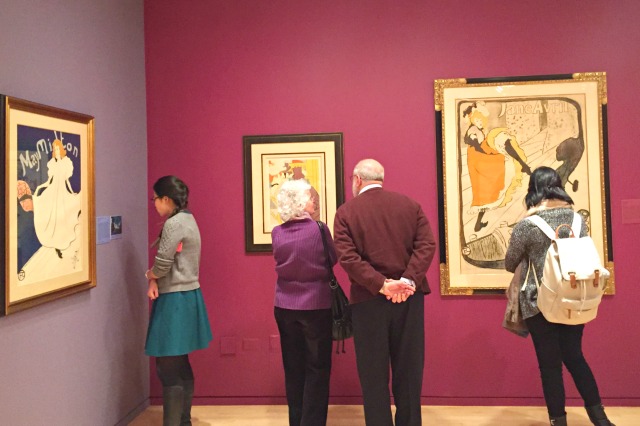Toulouse-Lautrec Print Exhibit, Curated By Northwestern Students, On Display
By Jessica Mlinaric in Arts & Entertainment on Jan 25, 2015 8:00PM

Credit: Jessica Mlinaric/Chicagoist
French artist Henri de Toulouse-Lautrec is the subject of a new exhibition at Northwestern’s Block Museum (40 Arts Circle Drive) in Toulouse-Lautrec Prints: Art at the Edges of Modernity, which features print work and advertisements by the fin de siècle luminary.
The exhibit is curated by Northwestern art history students under the direction of Professor S. Hollis Clayson. On Jan. 21, thirteen students presented their research in a lecture highlighting the collection and contextualizing the works. The exhibited pieces are on loan from the holdings of Irwin and Andra Press who have bequeathed their art to the Block Museum.
While many are familiar with Toulouse-Lautrec’s painterly renditions of vibrant life in Montmartre, this exhibit honors the significance of his commercial work. Mechanization enabled the growth of the print medium at the end of the 19th century. Loud and ubiquitous advertisements allured Parisian passersby and collectors began to view the commercial medium not as disposable ads, but as an art form. As graphics endorsing colorful entertainment began to leap from the city walls, grand in scale and palette, viewers were struck by the accessibility of lithography and postermania (affichomanie) ensued.
Henri de Toulouse-Lautrec was well poised for the onset of postermania. The aristocratic artist specialized in depicting the subjects on the margins of society including prostitutes and circus performers and notably, entertainers at Le Moulin Rouge. Toulouse-Lautrec’s work blurred the traditional boundaries between public and private spheres as well as high and low culture, and embraced the culture of celebrity at the burgeoning of modernism.
Toulouse-Lautrec Prints: Art at the Edges of Modernity features 18 pieces of print media created in the last decade of the artist’s life, including posters, theater programs and book covers. Clayson notes the diversity of Toulouse-Lautrec’s print work and the ability to showcase his range in this exhibit. The prints borrowed from the Press collection illustrate a spectrum of scale, technique, purpose, audience and venue.
Visitors to the exhibit should view the pieces through the lens of their reproducible nature. “We intend the modernity of mechanization and reproducibility to be highlighted by this exhibition of lithographs,” said Clayson. The exhibit is presented in a brightly painted gallery, intimating the exuberance of the fin de siècle and Lautrec’s colorful companions. Rather than the lurid faces of Le Moulin Rouge we so often associate with Toulouse-Lautrec, here we see prostitutes that have been desexualized, bourgeois pursuits of sport and leisure and the ever present depiction of Jane Avril representing a new female agency, whether as dancer or art collector.
Students from Clayson’s fall 2014 art history class curated the exhibit. It began effectively when they selected the piece(s) they wanted to borrow and worked intensively for the whole quarter,” she said. “They were entirely responsible for the interpretation of the pieces they chose.”
According to Clayson, “(Toulouse-Lautrec’s) production of prints shows his immersion in and contribution to one of the key developments in the visual culture of the later nineteenth century, the proliferation of prints and the related emergence of postermania. In Lautrec's oeuvre numbering more than 6000 works, there were 737 paintings and 369 prints and posters.”
Visitors are welcome to view Toulouse-Lautrec Prints: Art at the Edges of Modernity at the Block Museum through April 15. “We hope they appreciate the diversity of his lithographs in multiple categories, and enjoy our very colorful installation,” said Clayson.
Admission to the Block Museum is free and open to all. Parking is free on weekends and after 4 p.m. on weekdays.